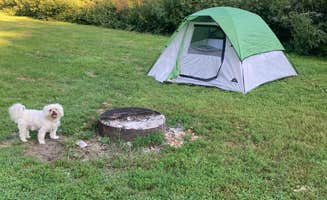Dispersed camping near Chatfield, Minnesota encompasses several state forest units within the driftless region, an area characterized by steep ridges, deep valleys, and unglaciated terrain. Primitive campsites in this area range from 800 to 1,300 feet in elevation, creating challenging but rewarding hiking conditions. Seasonal flooding along the Root River can impact water-accessible sites, particularly during spring snowmelt and after heavy summer rainfall.
What to do
Hiking the terrain: The Zumbro Bottoms State Forest offers accessible dispersed camping with hiking trails directly from the site. "This area is off a low maintenance dirt road. It is best to come in from the south as sometimes the gate on the river bridge to the north is closed," notes camper T S. about Zumbro Bottoms State Forest.
Water activities: The Root River provides opportunities for paddling and fishing while accessing remote campsites. At Root River Canoe Campsite, one visitor explains, "This was used and built by Boy Scouts ages ago. It's still exist, however the river changed course and is further away than it once was. There is a bike trail that had a fork in the road that leads right to it someone could walk, hike, canoe or kayak to access this campground."
Island camping: For boaters seeking primitive camping near Chatfield, Minnesota, Crater Island offers beachfront sites without facilities. Summer weekends draw larger crowds to this water-accessible destination, approximately 30 miles east of Chatfield.
What campers like
Scenic overlooks: The Richard J Dorer Memorial Hardwood Forest provides elevated camping with panoramic views. One camper at Richard J Dorer Memorial Hardwood Forest Isinours Management Unit shares, "There are a few spaces with views you can hike in to but I opted for a spot next to my car. And ideal spot for a one nighter. I stopped here after a 12 hour drive got set up and even walked the trails for a few miles before bed."
Solitude and remoteness: Less-developed sites in state forest units offer quiet camping experiences away from crowds. The Reno Unit features challenging terrain that limits visitor numbers.
Social gatherings: Some water-accessible sites become popular gathering spots. A visitor to Crater Island notes, "Big parties in the cove. No bathrooms no showers, just sand and water. Very busy on weekends in the summer, as long as there is no dredging operations going on, otherwise it's closed."
What you should know
Access challenges: Many sites require physical effort to reach. At Richard J Dorer Memorial State Forest Reno Unit, a camper warns, "This is an awesome place to hike, not a very long hike but it's steep with drop offs. Not for those that are scared of heights."
Limited facilities: Most dispersed camping areas lack basic amenities. The Root River Canoe Campsite offers minimal facilities with "a pit toilet, picnic tables, and a fire ring" but requires self-sufficiency for all other needs.
Seasonal considerations: Water levels fluctuate throughout the year, affecting access to riverside and island sites. Dredging operations occasionally close Crater Island, requiring flexibility in planning.
Tips for camping with families
Pack lightweight gear: For hike-in sites at higher elevations, consider specialized equipment. One experienced camper suggests bringing "a collapsible wagon to haul all the supplies up the hill" when accessing the overlook sites.
Consider car-accessible alternatives: Some locations offer both hike-in and car camping options. At Isinours Management Unit, campers can choose between scenic overlook sites requiring a hike or more accessible spots: "There are a few spaces with views you can hike in to but I opted for a spot next to my car."
Plan for no facilities: When camping with children at primitive sites, prepare for the absence of running water and restrooms. Bring sufficient water (1 gallon per person per day), portable toilet solutions, and waste disposal bags.
Tips from RVers
Size restrictions: Large RVs cannot access most dispersed camping in this region. Sites are generally limited to tent camping or small camper vans under 20 feet in length that can navigate narrow, unmaintained forest roads.
Alternative transportation: Consider using your RV as a base camp at established campgrounds, then accessing dispersed sites via secondary transportation. Bring bicycles to utilize the extensive trail system connecting to sites like Root River Canoe Campsite, which one reviewer notes is accessible via "bike trail that had a fork in the road that leads right to it."


